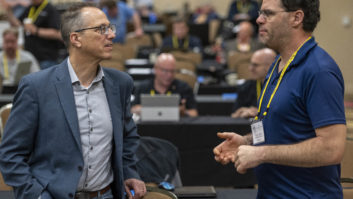How often do radio stations change transmitter buildings, apart from site moves and facility upgrades? Not very often, I suspect. In my 33-year career, I have never made such a same-site move — until recently.
Before we get into the meat of the project, let’s get the boring background stuff out of the way.
Crawford Broadcasting Co. purchased KLVZ (then KLTT) in 1994 as a daytimer on 800 kHz. In 2005, we changed frequency to 810 kHz and upgraded it to a split-site day/night operation, increasing daytime power to 2.2 kW using the existing three-tower array. At that time, we installed a new phasing and coupling system including phasor and antenna tuning units but using the existing transmission lines.
When we purchased the station, we inherited a 1970s-vintage construction trailer as a transmitter building. The site is in the flood plain of the South Platte River, so the trailer was elevated on eight 6-foot concrete piers.
By 2007, the building was starting to crumble around us, the result of more than 30 years of exposure to Colorado winters and wind. I wouldn’t have put money on such a trailer surviving that length of time on the ground, let alone 6 feet in the air where the elements had free access to all six sides! It really is amazing that it lasted so long.
About 10 years ago, CBC began purchasing prefabricated concrete transmitter buildings rather than building our own. There are any number of manufacturers of quality precast concrete equipment shelters, and these buildings can be custom-ordered with HVAC, electrical, grounding, equipment ladders, lighting and security already installed. They are delivered by flatbed truck and set in place with a crane, ready to connect to power, telco and RF cables.
I chose a precast 12-by-20 shelter for KLVZ for all those reasons, and because we were able to get a brand spanking new surplus unit originally ordered by Nextel for 30 cents on the dollar. Getting the county approvals was no walk in the park because of flood plain issues, but eventually we prevailed, and in late November of 2008, the building was in place on its piers.
By February of this year, we had power connected. We were essentially ready to go except for the small issue of frozen ground! Knowing that we would have to wait for the spring thaw gave us time to plan out the move.
The old building was located at the base of Tower 2, the center and reference tower of the array. The new (2005) directional pattern featured all positive power flow towers, so adding an equal length of transmission line to all three branches would result in a phase budget that wouldn’t require any ATU or phasor component changes. We would also add an equal length of sample line to all three branches of the sample system.
A location for the new building was chosen some 250 feet from the old building for a number of reasons. One has to do with power. We have plans to eventually upgrade this facility to 10 kW daytime, and three-phase power is required for that. The local utility charges by the inch to install new three-phase power line. Locating the building 250 feet closer to the road (and utility feeder) dramatically cut the cost of the upgrade.
Another reason is RFI. With the old building located so close to Tower 2, RFI and RFR have always been problems. We had to employ all sorts of screening to make the interior of the trailer both safe and equipment-friendly. Finally, by locating the new building relatively close to the county road, we would eliminate those long snowshoe treks in the winter just to check on things.
Challenge number 1 was to extend all the tower cables from beneath the old trailer to the new building. These cables included the transmission and sample lines, electrical power (for tower and security lighting and pattern switching) and control cables. We also found that the telco cable feeding the old trailer was not telco-owned — it was ours, and thus our responsibility to get it to the new building.
Challenge number 2 was, believe it or not, prairie dogs.
Colorado is home to lots and lots of prairie dogs. They are cute little critters, but they are terribly destructive. There is no such thing as a “direct burial” cable where prairie dogs live, and we have a large colony at the KLVZ site. All the cables would have to be sheathed in schedule-40 PVC conduit.
The third challenge was the phasor. Its width is 35-1/4 inches; the door opening on the new building was 34-3/4 inches wide from stop to stop. Had we ordered this building new, we would likely have specified a 42-inch door, but this was a surplus building and we had to take what they had. The steel door frame was actually part of the concrete mold and as such is secured and filled with concrete.
The final and overarching challenge was time. To minimize down time, this project would have to be completed in a matter of days. We were hoping and praying for good weather, but once we started the work, we would have to go on, rain or shine. Thankfully, we had dry (but hot!) weather for the outdoor parts of the project.
Even the best battle plans go out the window when the first shot is fired. I knew that going in. But that didn’t mean that we didn’t need a good plan. We had one, and amazingly we were able to stick to it, staying on track throughout the project.
We had a good crew consisting of CBC-Denver Chief Engineer Amanda Alexander and her able helper, Keith Peterson. Mark Smith and Shay Awedia of NRC Broadcasting were also on hand to help, and we had general contractor Mike Kilgore, electrician Ryan and some general labor as well.
Here’s how it went.
MONDAY
We started the project on a Monday morning by disconnecting the sample lines from the antenna monitor and pulling them out from beneath the old trailer. This was no easy task. While most of the excess line was (presumably) buried somewhere beneath the old building, there was a good bit of excess simply wound up in the floor joists and secured with conduit clamps. We removed all those clamps and carefully pulled each line so that it was straight from the point where it exited the conduit.
Next, we did the same for the electrical cables, which were 10-3 Romex, and the control wires, which were seven-pair 22-gauge cables (why did they use such small wires?).
Finally, we took the site off the air and pulled the transmission lines out of the phasor. Like the sample lines, the transmission lines (two 1/2-inch foam lines and one 7/8-inch foam line) also had excess coiled up in the floor joists. We had to remove the securing clamps and pull those out straight.
The next step was carefully to cut off the 3-inch PVC conduits containing all the transmission, sample, control and electrical lines a foot above ground level so that we could splice all those cables. We did this with a Dremel and a hacksaw blade, and we were successful in getting the conduit cut without damaging any of the cables inside. We had to do this for four different pipes — the ones containing transmission and sample lines, one containing electrical cables and one containing the telco cable. It was a lot like a doctor removing a cast!
The remainder of Monday was spent disconnecting equipment, emptying the racks and preparing everything for the 250-foot move to the new building. The general contractor was on site with a trencher, cutting a trench for the cable extensions to the new building.

Assisted by Keith Peterson, the author pulls 7/8-inch transmission line off the spool. TUESDAY
Day two of the project was perhaps the hardest. It was certainly the hottest!
We had a roll of 300 feet of 7/8-inch foam line, a roll of 600 feet of 1/2-inch foam line, a roll of 900 feet of 3/8-inch foam line, a roll of 1,000 feet of 10-3 with ground U/F electrical cable and a roll of 1,000 feet of seven-pair AWG-16 control cable. All that had to be pulled off the spools and cut.
We took particular care in measuring and cutting the 3/8-inch sample lines. The manufacturer provides a mark every meter of length, so it was a fairly simple matter of watching those marks go by, checking our math twice and cutting at the appropriate place. We did the same with the 1/2-inch line, cutting it into two equal-length pieces.
The electrical and control cables were pulled out to the same lengths as the transmission and sample lines and cut. Finally, we pulled out and cut two Cat-5 plenum-rated cables that we would use to extend the telco cable. While there was a 25-pair cable to the old building, only six pairs were terminated and only one pair was used (for ISDN). The two Cat-5 cables allowed us to extend eight of the pairs.
Pulling and cutting the cables was the easy part. Next, we had to sheath them with the schedule-40 PVC conduit. We had two 3-inch pipes and one 2-inch. There was no good way to pull transmission lines through the complete 250-foot conduits, so we didn’t even try. We laid the cables out on the ground and grouped them. Next, we slid the 10-foot conduit sections over the cables, gluing up the joints as we went. By the end of the day, all three pipes were in the ground with the extension cables inside. That was one long, hot, tiring day.

Cris drills through the telco-style splice pedestal. Cable splices were made with connectors and 90-degree ‘elbows.’ WEDNESDAY
We had extra help on hand to assist with relocating the transmitter and phasor to the new building and it’s a good thing.
The general contractor and I had spent some time noodling on how to get the phasor through the too-narrow door opening on the new building, and we came up with a plan: We would use a disk grinder to cut the striker-side stop off the frame from the floor to about 48 inches up. The GC did that while my helpers and I took the side panels off the phasor, not to make it narrower — the aluminum trim extrusions were not removable and they defined the width — but to keep us from scratching them up in the move.
Finally, we were ready. The fork lift was brought in and we loaded the phasor on it, transporting it to the new building. Once there, we laid the phasor cabinet on its back, raised it up to the new building and carefully threaded the needle with it. The phasor slid through the door with a couple of millimeters to spare! Once inside, we had to stand it back up, no easy task with the cable ladder overhead. We found a spot with enough headroom and put the phasor back upright. Whew.

The phasor is removed from the old building by forklift.

The 60,000 pound pre-fab concrete building is set in place on its elevated foundation with a crane. The transmitter, a Nautel ND-2.5, was much easier to move (though it was a lot heavier than the phasor). We had hand-carried the rack into the new building on Monday, so it was already there.
We had an electrician on hand to help us get the extension cables into the new building. He and our helpers completed the conduit runs and building penetrations. It was no easy task, but they got those rather uncooperative cables all into the new building.
While all the moving was going on, Mark Smith was working under the old trailer splicing the cables. We purchased a 14-inch diameter telco-style splice pedestal for this purpose, and it worked out great. But just try buying only one of those … they usually sell them in lots of several hundred.

A very tight fit!

Central ground point for the halo ground system. The brazed connection at the bottom center goes to the ground rod array. The strap connection ties in the building RF ground. The wire on the right ties in the bus bar for the transmission line entry grounds. Finally, we completed the grounding. The new building includes a “halo” grounding system (those wireless folks are serious about grounding!). We installed an array of seven rods beneath the new building, tying them all together and connecting that to the halo system in the building. We also brought in a strap from the station ground system and tied it to the central point of the halo system.
THURSDAY
The electrician was back on Thursday, and I had a pretty good list for him. The new building was pre-wired, but the circuits feeding the transmitter, phasor, rack and towers all had to be routed and terminated. The tower light circuits also had to have current transformers installed for remote monitoring.

Amanda Alexander wires up the Ethernet switch. While the electrician was doing his thing, Amanda, Keith and I were wiring up the remote control, Ethernet connections, audio, etc. By afternoon, with the electrician gone and out of the way, I started on the transmission and sample lines. I used our network analyzer to “tune” the sample lines carefully to the exact same resonant frequency before installing connections. I had measured them before vacating the old building and made sure that they were all the same electrical length. Now all I had to do was get the new lengths equal. Piece of cake — our careful field cutting of the lines paid off. Keith got the STL up and running, restoring both audio and WAN connectivity to the site.
At about dinner time, all the sample and transmission line connections were made and we were ready to fire the site back up. It came back up just fine, and everything was in the ballpark. With just a little tweaking, I “nailed” the licensed operating parameters on the antenna monitor.
It was a long day but a good, productive one. The end was in sight.
FRIDAY
We ended the week with cleanup and important but non-air-critical items.

The supplied overhead cable ladder made cable routing and management a snap.

Completed cable splices in the telco pedestal. We had called the security contractor to have them come and move the fire/burglar alarm system to the new building, but they couldn’t get there for several days. It occurred to me that we could move it ourselves, so we did (the contacts were already pre-installed in the new building). We later had the security company come back and check the system and installation over, but by the end of the day Friday we had the new building protected.

On the air from the new building! A welder came and reinstalled that cut-off piece of the door frame. The GC ground the welds smooth and painted the frame. Now you can’t tell that it was ever removed. We have created the classic “ship in a bottle!” Grinding off the stop turned out to be an excellent solution. The door frame is still secured in concrete and retains all of its strength.
Keith activated the video security cameras and DVR, restoring 24-hour video surveillance of the site.
I spent some time tweaking the IBOC operation. The transmission line extensions had produced a rotation of the load presented to the transmitter, and this shift was in our favor. In the move, we were able to eliminate a “line stretcher” network that had been used in the old building. I got good IBOC performance and a clean spectrum from the new facility.
FINISHING UP
As we prepared for this project, I had it in mind to license it under the FCC’s new modeling rules. KLVZ’s daytime array has long suffered from monitor point anomalies caused by nearby construction cranes. The cranes did not affect the far field, but they did play havoc with the MP field strengths. In 2007 I augmented the pattern to heavily fill the nulls and gain some breathing room at the MPs, but by modeling the pattern and licensing it under the new rules, I could forget about MPs forever.

The 14-inch diameter pedestal provides a secure, dry and accessible environment for the splices. Amanda and I took a couple of days the week after the project to wrap up the modeling part of the project. We had measured the base impedance matrix before the project began, and the sample lines had been measured during the project. What remained was calibration of the sample transformers (TCTs), adjustment of the array to the model parameters and measurement of the reference field strengths.
I removed the TCT from each ATU cabinet, carefully marking them as to which tower they came from, then took them all to the transmitter building. I then connected them all to the antenna monitor through short lengths of Andrew Sure-Flex cable and looped a piece of AWG-12 wire through them, connecting each end of that wire to a J-plug in the phasor. It was a simple matter to turn the transmitter on, calibrate the antenna monitor internally, then read the phases and ratios from the three TCTs on the monitor. After reinstalling the TCTs I adjusted the array to the model parameters. This really didn’t take much — it required a two-degree shift on one tower and less than a 5 percent current shift on both non-reference towers. Keith and I spent a couple of hours tuning the ATU networks for a transmission line match while Amanda chased us with the phasor controls.
With all that done, we re-touched the IBOC settings, then hit the road to measure three points on each of the null and major lobe radials. I did the paperwork and filed the application. Job done!
On the surface, moving to a new transmitter building may seem like a relatively simple project. Trust me, it’s not. There are many things to consider, especially with a directional AM. Arrays that employ negative power flow towers will likely have to undergo a complete phasing and coupling system redesign.
The secret to a successful move is good planning. Don’t get in a hurry. Think things through carefully and plan for contingencies. There was much that we didn’t know going in, but we were prepared. That planning and preparation paid off.
Cris Alexander is the director of engineering at Crawford Broadcasting and a recent recipient of SBE’s Broadcast Engineer of the Year award.












